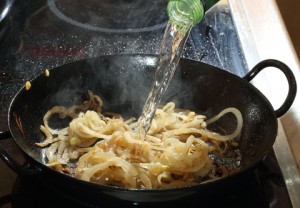 There are countless rules surrounding wine, but one of my least favorites is the old-fashioned guidance, “Always cook with the same wine you will be drinking.” I remember the first time the rule struck me as one I would not be following in my kitchen. I was making beef stew and the recipe instructed me to add two cups of red wine. It just happened the wine I was serving and had opened for dinner was a beautifully aged Bordeaux. I could not convince myself to pour half of my bottle into the pot. Thus beginning my exploration of wine being used as a cooking ingredient.
There are countless rules surrounding wine, but one of my least favorites is the old-fashioned guidance, “Always cook with the same wine you will be drinking.” I remember the first time the rule struck me as one I would not be following in my kitchen. I was making beef stew and the recipe instructed me to add two cups of red wine. It just happened the wine I was serving and had opened for dinner was a beautifully aged Bordeaux. I could not convince myself to pour half of my bottle into the pot. Thus beginning my exploration of wine being used as a cooking ingredient.
Many cooks have experimented using different wines (ranging from the least expensive to super premium) in the same recipe. Generally the results were similar, but with a few notable exceptions. Wines in lowest price range tend to be either slightly sweet or bland and generally imparted these characteristics to the final dish. Premium wines tend to be very flavorful but lose their nuance as they cook. In general the best wines to cook with fall in the middle, $8 to $12 wines with simple flavors and aromas.
Be cautious of using grocery store “cooking wine,” as it tends to have additional additives and excessive salt and likely will change the taste of a recipe calling for red or white wine.
When faced with the typical vague instruction “2 cups dry white wine” or “1 cup red wine,” opt for a dry style unless the recipe is specific in listing a sweet wine as an ingredient. However, if a wine label reads “fruity,” this does not mean sweet. A safe white wine is chardonnay, and for reds, cabernet sauvignon, merlot and pinot noir are good options.
A wine that is often overlooked is dry vermouth. Most famous for its role in martinis, this dry white wine has been steeped with various spices, herbs and seasonings. It’s known as the chef’s secret because it adds interesting lightly spicy hints to sauces.
The longer the dish is cooking, the more of the wine’s character is lost. For long-simmering dishes, the specific wine is less important than one for a quick saute. Also consider the color. White wine is generally used in most stocks and sauces because the red wine would change the color of the food.
If you are concerned about alcohol, it is important to note that alcohol boils at about 178 degrees, so if you are braising, boiling, or cooking the food for a prolonged period most of the alcohol will evaporate off. In briefly cooked dishes, as much as 85 percent of the alcohol may remain.
My advice is to follow the guidelines, but save your best bottle of wine for your glass and not the cooking pan.